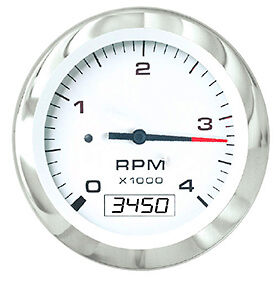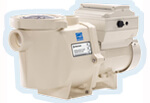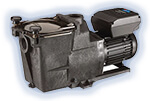FREE Standard Shipping On All Orders $100 or More!*
Installing a Variable Speed Pool Pump

Imagine running your car at 3450 RPM - all the time! Think of the gas expense and the wear and tear on your engine, if you raced around with the tach at 3500!
Well, that's what your standard pool pump does everyday. The motor shaft inside spins at over 3400 rpm, which uses a lot of energy and puts out a lot of heat, about 150° - too hot to touch.
A Variable Speed (VS) pool pump operates at several speeds - low, medium or high, to optimize energy usage. The long-life, permanent magnet motor is cool to the touch, and is quiet as a breeze. But the best part is, VS pool pumps can save up to 80% in electrical cost.
By 2021 - most new pool pumps sold in the U.S. are required to be Variable Speed, as mandated by the US Energy Dept.
Variable Speed Pool Pumps

The Pentair Intelliflo VS pool pump is Pentair's flagship VS pump, made for over 15 years. With 2" unions, and speeds from 600-3450 rpm, capable of producing over 150 gpm, it can handle large waterfalls, or pools over 50,000 gallons. The IntelliFlo has 8 programmable speeds and times.

The TriStar VS pump is one of two new VS pool pumps that are attractively priced 33% less than the EcoStar. With 2" unions, the Max Flo VS has 3 programmable speeds of 600-3000 rpm, capable of flow rates of over 100 gpm, for pools over 40,000 gallons, or large water features.

The Super Pump VS is a familiar design, mates up to existing superpumps and uses many of the same parts. 1.5" pipe connections and 3 programmable speeds of 600-3000 rpm, with flow rates of up to 75 gpm, for pools up to 30,000 gallons.
No matter what size your pool is, VS pumps are programmable to the right speed needed for the job. VS pumps "dial-in" the most effective speed, to match the pipe size, filter size and pool size - for the most efficient operation possible.
VS Pool Pump Installation
Remove Old Pump: With the pump off, use a hacksaw to cut through the pipe that comes into the pump and the pipe that comes out of the pump.
Cut at a location where you have 2-4" of clear pipe, to connect a pvc coupling or other fitting to connect in and out of the new pump. In some cases you may need to sacrifice a valve, or cut back further on the pipe, to where you can connect a new fitting.
With the pump plumbing cut, remove the bare copper wire, or bonding wire attached to the motor. Shut off the power at the breaker before opening the rear of the motor and removing the 3 wires that come into the pump - 2 power lines and a ground wire. Loosen the conduit connector, pull the wires out of the pump - and now you can move the old pump out of the way.
Wire up New Pump: You must have 230V to wire a VS pump. To determine your current voltage, you can check your timeclock label or the wiring diagram on the motor, or use a AC volt meter to check the incoming power.
For most inground pools, an existing 15 or 20 amp breaker, and 230 volts is perfect. Just simply bring the old pump wires into the motor drive by removing the access cover. Follow the diagram label to connect your two 115V leads, and your ground wire, then tighten up the conduit to the box.
Variable speed pumps don't get wired into the back rear of the motor, like standard pool pumps, but rather into the Variable Drive unit. On the side of the box or control panel mounted onto the motor is where we are going to bring the 2 hot leads or wires, from the breaker.
Attach the flexible conduit fitting onto the drive motor housing, and connect both wires, attaching them to L1 and L2. It doesn't matter which wire connects to L1 or L2. The ground wire should attach to the green screw.
Reconnect your bonding wire and the wiring is complete! If you currently use a timeclock for your pool pump, the programming interface makes it obsolete. Just remove the 'OFF' timer and leave the switch turned on.
As compared with two-speed pumps, wiring up a VS pool pump is a cinch! No need to add a fourth low-speed wire, and switch out the timeclock. In fact you don't need a timeclock at all anymore, as your new VS pump has a built-in timer.
Plumb the New Pump: If you are replacing a regular Max-Flo or SuperPump with the New VS models, the plumbing will line right up, and you can even reuse the old fittings. If needed, you can adjust the pump base or shim the pump to raise it to the level to meet incoming pipes.
Glue 2" PVC pipe directly into the unions on the MaxFlo and EcoStar, or wrap the threaded 1.5" fittings of the SuperPump 5x with Teflon tape, and tighten it into the pump. Be sure to use fresh PVC glue and primer for best results with glue joints.
Allow the glue to set up for just a few minutes, and you can prime up the pump basket with water and test out your new VS pump.
Reducing restriction is very important for a VS pump, if you want to realize the most energy savings. Sweep elbows and 2 or 2.5" pipe is recommended, as well as other ways to reduce resistance in the system, such as high flow cartridge filters, and removing unused equipment in the plumbing system.
Re-plumbing to reduce the number of 90's used can make a big difference, as does replacing a side-mount Multiport valve with a Slide Valve for sand and DE filters, or swapping a 1.5" Multiport with a 2" Multiport. The less restrictive you can make the circulation system, the more money you will save!
Menu driven interface guides you through set-up and programming of your run times and run speeds.
From the get-go, you'll start saving 75% of your pool pump electrical expense. Just by working smarter, not harder! For more information, see our full line of Hayward VS pool pumps in our Hayward Pool Pump Superstore!